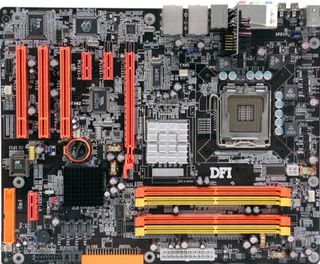Market Survey, Part 1: A Comparison Of The Latest Pentium 4 Motherboards
DFI LANParty 925X-T2 (Intel 925X)

Board revision: A
BIOS version: January 13, 2005 (beta)
LANParty motherboards have nearly become a tradition at DFI. What started out as an innovative idea has now become well-enough established to give DFI a solid reputation as a serious player in the LANParty business.
The 925X-T2 board is built around Intel's 925X chipset. It has a VIA Firewire chip and two Gigabit network connections, one via PCI and a second via PCIe. The LANParty board features three PCI slots, and two x1 PCIe interfaces are also at the ready, for future upgrades. A third slot is located at the bottom edge of the board, potentially for mass storage controllers that don't have to be connected outside.
For BIOS tuning fans, DFI offers the "CMOS Reloaded" function. This allows you to save all settings to be called up again later if needed. This is useful, for example, when you want to set up different modes for quiet operation and max performance.
The included accessories are abundant, as we have come to expect. In addition to a PCTranspo carrying strap system, there is a Secure FrontX front panel module, bringing audio, Firewire, status LEDs, and an SATA interface to the front of the case inside a 5.25" bay. The SATA connection doesn't make much sense though without the appropriate power supply. An analog headphone connection would without doubt have been the better choice for LAN parties instead of the digital ones. The i.LINK port (Firewire) makes sense for rapid data transfer with external hard drives.
The shutter is of questionable value, because its large-sized apertures won't protect against dust. Fortunately, it can be quickly taken off though in a single step. And one other point of criticism: its imposing black color sometimes makes it difficult to find the desired ports at dark LAN parties. Some brightly-colored lettering, perhaps matching the orange of the motherboard components, would be of help. Twenty UV-active cable ties are included to go with the glow-in-the-dark board (see photos).
Stay on the Cutting Edge
Join the experts who read Tom's Hardware for the inside track on enthusiast PC tech news — and have for over 25 years. We'll send breaking news and in-depth reviews of CPUs, GPUs, AI, maker hardware and more straight to your inbox.
An adapter is also included for operating UltraATA devices on the board's SATA ports. DFI makes a point of emphasizing that they only use long-life, Japanese-made condensers - an important quality feature. This same quality is not found everywhere though. For example, the round IDE cables are nice, but the wires are not threaded individually through the rubber sleeving - instead, they are just regular cables crammed inside the sleeving, which could lead to cable damage with frequent use.
DFI stands for fair play: the board clocked exactly at 200.0 MHz. See? It can be done.
Current page: DFI LANParty 925X-T2 (Intel 925X)
Prev Page Biostar P4TAW Extreme, Continued Next Page DFI LANParty 925X-T2, ContinuedMost Popular

